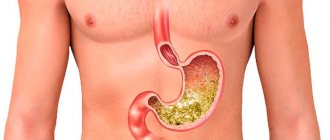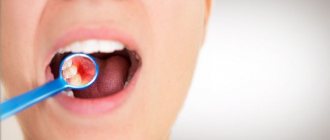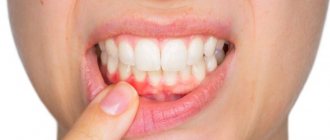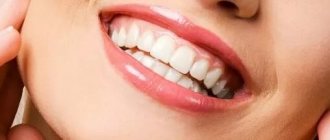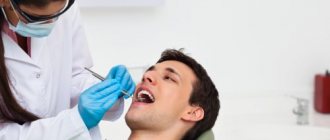Halitosis affects about a quarter of the US population. It is interesting to note that during my lecture at the Hinman Dental Conference on halizote, I asked the audience who in the audience thought they had bad breath. About 80% of those present raised their hands. I was shocked because these were people working in dental clinics!
Now you can imagine why selling consumer products designed to combat bad breath is a four billion dollar a year business. There is no doubt that dentists should include the treatment of bad breath in their treatment plans and in the work of our clinics in general.
Thank God that scientists and researchers are studying such an urgent problem as halitosis. It is known that more than 90% of the sources of unpleasant odor are associated with the oral cavity and are the result of the decomposition of protein residues by anaerobic bacteria, which leads to the formation of volatile sulfur compounds. Such volatile compounds are usually methyl mercaptan and sulfide hydride, which have the smell of “rotten eggs” or hydrogen sulfide. Typically, patients can pinpoint the location in the mouth where they think this “aroma” is coming from, because these gaseous compounds have a very pungent odor. I have had many patients say, “Oh, that smell is coming from between my central incisors,” or, “I get a nasty taste from the spaces between my upper molars on both sides.” In some cases, the sources of bad breath may be in the nose, throat or stomach. Unfortunately, consideration of all possible causes of unpleasant odor is beyond the scope of this article. Suffice it to say that in most cases the problem is related to the oral cavity, and therefore we, dentists, are the very specialists who are actually supposed to cure bad breath.
Your nose is an excellent smell detector and is by far the most advanced odor analyzing device on the planet. Your nose can smell up to ten thousand different smells and is extremely sensitive to sulfur compounds.
Diagnosis of halitosis
Diagnosing bad breath is a difficult but interesting case. A questionnaire should be completed that includes questions about the patient's medical history, medications, diet, tobacco and alcohol consumption, oral hygiene habits, including the use of any commercially available rinses, toothpastes, or whitening products, and any other habits of the patient.
A thorough oral examination is the next step in identifying the causes of halitosis. It is necessary to assess the condition of the gums and hard tissues of the teeth and resort to various methods for diagnosing halitosis:
1. Clean the medental spaces in the area of the upper and lower molars with floss. After 45-60 seconds, evaluate the smell of the floss
2. Treat the back third of the back of the tongue with a sanitary napkin and after 45-60 seconds evaluate the smell of the removed plaque.
3. You can evaluate the intensity of bad breath using a special device - a halimeter
, to measure the concentration of volatile sulfur compounds during exhalation. This device allows you to evaluate how successfully the treatment is progressing.
4. Microbiological tests can be used to identify bacteria that cause halitosis.
What causes the stink: dental reasons
Halitosis is caused by pathogenic microorganisms. Unfortunately, it is not always possible to remove them using normal hygiene procedures, because we can talk about various diseases that require treatment. Let's consider several ailments that can provoke a similar symptom:
- Insufficient hygienic treatment. A standard brush and toothpaste do not thoroughly clean plaque and food particles that are stuck between the teeth. For this reason, dentists strongly recommend adding rinse, floss, and irrigator to your arsenal. It is advisable to carry out all hygiene procedures after each meal to prevent the accumulation and compaction of plaque.
- Pathological processes localized in the gums. Bad breath usually occurs due to gingivitis, periodontitis, or periodontal disease. To eliminate this problem, it is necessary to treat the root cause and restore gum health.
- Presence of carious cavities. In a colloquial format, they say about this disease that “the tooth is rotting,” so you don’t have to wonder where the foul aroma comes from. If the cavities are large, they are constantly filled with food, which is quite difficult to get out even with the most modern hygienic devices.
- Stomatitis. This disease is characterized by the appearance of small whitish dots filled with pus. They promote the active proliferation of pathogenic microorganisms and provoke the appearance of stink from the mouth.
- Stone formation. Dentists assure that even banal tartar, which occurs in every second person, provokes this symptom. The solution is to remove the stone in the doctor's office.
About the causes of smell in the program “Live Healthy”
What to use
In general, part of the plan for treating bad breath is the use of hydrating, non-alcoholic mouth rinses. Because most of the bacteria that produce volatile sulfur compounds are gram-negative anaerobic bacteria, we need a way to provide significant amounts of oxygen to these bacteria to prevent them from multiplying.
Many patients prefer to purchase commercially available oral hygiene products because they are widely available and taste good. I explain to patients the need to use oxidative, non-alcoholic, antibacterial mouth rinses. There are very few such funds on the market. We recommend to our patients several products to choose from: Rembrandt refreshing rinses with mint or exotic flavors produced by the Den-Mat corporation. All of them do not contain alcohol, have antibacterial properties and taste good.
You should also pay attention to the use of toothpastes. To treat bad breath, it is necessary to use toothpastes and gels that have the ability to release free oxygen. Few commercially available toothpastes contain peroxide. Among the affordable and effective remedies on the market, I suggest toothpastes containing carbamide peroxide to patients being treated for bad breath. Such pastes include Rembrandt Plus or the Rembrandt “Delightful Whiteness” whitening system, which are available in retail stores and pharmacies.
A tongue brush or scraper is another much-needed tool for treating bad breath. The toothbrush is usually too large to reach the root of the tongue without causing nausea in the patient. Tongue brushing has been shown to be effective in reducing the number of microorganisms on the tongue and helping eliminate volatile sulfide compounds, which are the main cause of bad breath. As our practice shows, this procedure is readily accepted by patients. This is the key to treating bad breath and is an integral part of it.
Efficiency
The effectiveness of hydrogen peroxide in combating unpleasant odors has been clinically proven. But, like any other remedy, it has pros and cons.
Advantages:
- The antiseptic capabilities of this product allow you to get rid of a large amount of bacterial flora, which provokes various dental diseases. For example, caries occurs as a result of a staphylococcal infection that settles on the tooth enamel.
- Once hydrogen peroxide enters the oral cavity, it instantly begins to fight bacteria.
- Hydrogen peroxide is available to everyone due to its low cost.
This product has one drawback - an unpleasant aftertaste that lingers in the mouth for a long time, but it can be easily removed by rinsing your mouth with clean water.
Attention! The use of hydrogen peroxide does not eliminate the need for daily oral hygiene using toothpaste and a toothbrush.
Proper oral care is not all that is needed to treat halitosis
For many patients suffering from bad breath, proper oral care, proper periodontal treatments, brushing the tongue and using appropriate rinses are not enough.
The new treatment method proposed by the author involves the use of specially modified whitening trays, the edges of which extend beyond the gingival margin by 3 millimeters. These mouth guards are made without any cushioning material on the teeth. The same plastic is used to make whitening trays.
The essence of the method of using such non-standard mouth guards is that the oxygen gel freely penetrates into the area of the gums, tongue and palatal or lingual surfaces of the teeth. It is best to use gels containing 3-10% carbamide peroxide.
The frequency and duration of wearing such mouthguards depends on the specific symptoms described by the patient. For example, if morning breath is annoying, the patient is recommended to wear mouth guards with carbamide peroxide before bed and keep them in the mouth all night. If the smell appears in the evening, then patients should wear mouth guards for some time during the day. For those who feel and smell bad breath from their mouth throughout the day, it is suggested to wear mouth guards for half an hour in the morning and half an hour in the evening. This treatment of patients continues for two weeks, after which its effectiveness is assessed. At the appointment, when it is carried out, the freshness of the patient’s breath is analyzed. If it is necessary to continue treatment, the patient may be offered a higher concentration of hydrogen peroxide or carbamide peroxide, or recommended to wear mouth guards with the medicine more often. As a general rule, treatment for two weeks is usually more than enough to eliminate bad odor. After this, patients are advised to use non-alcoholic oxidative rinses and toothpastes, maintain proper oral hygiene and brush the tongue.
What is this substance?
Hydrogen peroxide is a combination of two oxygen molecules and two hydrogen molecules; it is colorless and odorless. The substance is very unstable and quickly disintegrates upon contact with pathogenic flora.
Reference! When hydrogen peroxide breaks down, molecular oxygen is formed; it has an oxidizing property, which is why it is used in medicine as a disinfectant.
Hydrogen peroxide is used only externally; internal use is not practiced . More than a hundred years ago, medical scientists found that rinsing the mouth with hydrogen peroxide is absolutely harmless. At that time, diphtheria and stomatitis were treated with this substance.
Hydrogen peroxide comes in different forms:
- Solution – 3%.
- Concentrated solution – perhydrol – up to 31%.
- Hydroperite – 35%. Available in tablets.
To rinse the mouth, you can use a 3% solution and hydroperite after dissolving it in water to the desired concentration. Perhydrol is used in pharmacology, as well as for disinfection of premises.
Advantages of the technique
Treating cases of bad breath will greatly benefit the practice. Unobtrusive internal marketing is very effective in informing patients that you provide this type of treatment. Once word got out that our clinic treated cases of bad breath, we were inundated with requests for help from spouses, co-workers, siblings, pharmacologists, physicians, hygienists, and other dentists. Many of the patients we treated also wished to undergo treatment for bad breath.
Once it becomes known that your clinic treats bad breath, your patients will have significant interest in restorative and cosmetic treatments. Once patients feel their breath is fresh after treatment for bad breath, they will naturally begin to pay closer attention to other oral problems in order to look their best.
Treatment of halitosis is a large part of my practice because many patients are referred to me by my colleagues and satisfied patients who tell their friends about this program. A dentist who implements the treatment of bad breath into his practice will receive professional satisfaction and some financial benefit from it.
Treating bad breath is a very beneficial component of dental practice. Clinic staff are always equipped to incorporate this type of treatment into their daily practice. Much of the treatment of halitosis, which includes making mouthguards, alginate impressions, training, and dispensing treatments, can be delegated to support staff.
How to dilute hydrogen peroxide for your mouth
The product can be purchased at the pharmacy in three types:
- aqueous 3% solution;
- concentrate at 33%;
- hydroperide tablets (35%).
For rinsing procedures, a 3% solution is used.
If such a solution is not available, then add 1 tablet or 1-3 teaspoons of concentrate per 100 ml of water.
Hydrogen peroxide should definitely be diluted with warm water; if this is not done, you can get burned.
The rinsing procedure is quite simple. First, a solution of the required concentration is prepared, then it is taken into the mouth and the cavity is rinsed for a minute.
After the procedure, the liquid is spat out. These steps should be repeated at least two more times.
You should not overdo it in treatment; rinsing your mouth with peroxide more than five times a day is not recommended.
Experts advise adhering to the following rules when carrying out the procedure of rinsing the mouth with hydrogen peroxide:
- rinsing should be done 3 to 5 times a day;
- the duration of the course must be at least 3 days;
- do not be alarmed if during the procedure you feel a tingling sensation and foam appears;
- The water should be warm.
A better effect can be achieved if you use it together with other media, such as herbal decoctions, soda and salt.
Information about the author of the method
Dr. Louis Malcmacher runs a private clinic in Cleveland, Ohio. He is also a researcher and consultant for Dentique Inc., a dental products and business consulting firm. Dr. Malcmacher is a frequent contributor to dental journals and has published numerous papers on adhesive resins in dentistry, bridges and crowns, dental practice management, periodontics, cosmetic dentistry and, most recently, the treatment of halitosis. He is also one of the authors of a popular monthly newsletter on new methods and materials, overhead reduction and practical management. Dr. Malcmacher is a panelist for the Association for Clinical Research, a visiting lecturer at the New York University School of Dentistry, editor of Dentistry Today, a speaker for the Academy of General Dentistry, a consultant to the American Dental Association's Council on the Practice of Dentistry, and has been named one of the Leaders in Advancement. Qualified by Dentistry Today magazine.
Dr. Malcmacher is an internationally recognized author and lecturer known for his thorough and entertaining style. He works closely with dental product manufacturers as a consultant and clinical researcher in the development of new products and techniques. For nearly two decades, Dr. Malcmacher has inspired his audience to truly enjoy being a dentist, providing the essential knowledge for excellent clinical and practice management. His group's dental practice has grown 45% since 1988.
Louis Jay Malcmacher DDS, FAGD www.medicus.ru
medicinform.net
Hydrogen peroxide for bad breath: pros and cons
Reviews about the use of hydrogen peroxide to get rid of halitosis are mostly positive. The product allows you to accelerate the restoration of the oral cavity after caries, stomatitis, gingivitis, and periodontal disease. In addition to diseases of the teeth and gums, hydrogen peroxide is effective for the prevention and treatment of chronic diseases of the throat and nose: pharyngitis, sore throat, laryngitis, rhinosinusitis, sinusitis, etc.
If you use exclusively the above “working” solution, without increasing the concentration of the main component and without using it to rinse the mouth too often, then it does not pose a danger to either adults or children.
Among the disadvantages, first of all, there is a specific and unpleasant aftertaste of the solution, which you can get rid of by drinking herbal tea or rinsing your mouth with an infusion of chamomile, sage or oak bark.
Also, if used incorrectly, hydrogen peroxide can severely damage the oral mucosa.
Finally, it is important to consider that this solution is a symptomatic remedy, and using only it, the source of the disease cannot be eliminated. Hydrogen peroxide helps only in combating symptoms.
